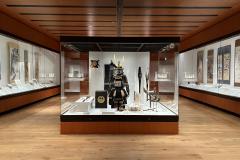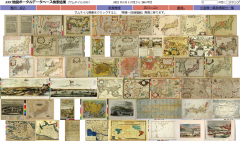-
[イベント情報]2025年6月 3日(火)
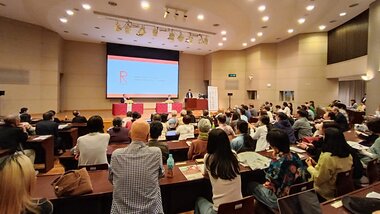
On June 1, 2025, Ritsumeikan University's Kinugasa Campus hosted the KINUGASA ART VILLAGE FESTIVAL to commemorate the 125th anniversary of the founding of the Ritsumeikan Academy.
As part of the festival, the Art Research Center (ARC) held an art dialogue titled 'Ukiyo-e and its Global Reach,' featuring two renowned ukiyo-e experts: Dr. Shugo Asano and Prof. Ryo Akama.
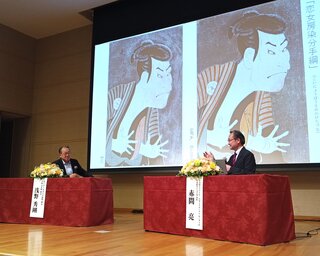
Dr. Shugo Asano serves as the President of the International Ukiyo-e Society and is the Director of both the Abeno Harukas Art Museum in Osaka and The Museum Yamato Bunkakan in Nara.
Prof. Ryo Akama, of the College of Letters at Ritsumeikan University, is the Director of the ARC and a pioneer in the digital archiving of Japanese art held in overseas collections, having spearheaded the creation of the world's largest ukiyo-e online research database.
Ukiyo-e, widely recognized through its presence on banknotes, passports, and popular TV dramas, also includes many lesser-known works that have remained 'hidden' within museum collections around the world. During their conversation, Dr. Asano and Prof. Akama highlighted the enduring appeal of ukiyo-e and discussed how masterpieces by artists such as Hokusai, Kunisada, and Kuniyoshi are exhibited not only in Japan but also in prestigious museums worldwide, including the British Museum and the Museum of Fine Arts, Boston.
Their insightful exchange offered attendees a unique opportunity to deepen their understanding of ukiyo-e's cultural significance and its far-reaching international influence.
Looking ahead, with the establishment of the College of Arts and Design on Kinugasa Campus next year--where Prof. Akama will serve as dean--Ritsumeikan University is excited to host further events that celebrate and explore Japan's extensive artistic heritage in a global context.
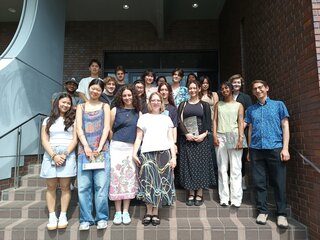
2025年5月22日、ノースイースタン大学の短期留学プログラム「Dialogue: Shoshin Japan: Art, Craft, and Design in Kyoto」の一環として、同大学の学生グループがアート・リサーチセンター(ARC)を見学されました。一行は、ノースイースタン大「College of Arts, Media, and Design(CAMD)」 のアソシエイト・ティーチング・プロフェッサーであるJamal Thorne氏およびKate Terrado氏により引率されました。
ARCの建物や施設を見学されたほか、Travis Seifman氏(立命館大学衣笠総合研究機構・准教授/現ARCリサーチマネージャー)とデジタル人文学に関する相互連携について意見交換を行いました。
 With the establishment of the International Joint Digital Archiving Center for Japanese Art and Culture (ARC-iJAC) in 2019, the Art Research Center strives to push the internationalization of research activities that transcend disciplines and geographic boundaries.
With the establishment of the International Joint Digital Archiving Center for Japanese Art and Culture (ARC-iJAC) in 2019, the Art Research Center strives to push the internationalization of research activities that transcend disciplines and geographic boundaries.NEWS
Spring has arrived at Ritsumeikan University's Kinugasa Campus, where the grounds were for weeks beautifully adorned with cherry blossoms in full bloom.


The release of over 570 illustrated books, ukiyo-e painting manuals, and other early modern Japanese books marks the latest milestone in the collaboration between the Royal Museums of Art and History (MRAH) and the ARC, which began in 2007. Furthermore, 8,750 ukiyo-e prints previously released are also available through the ARC Japanese Prints (Ukiyo-e) and Paintings Portal Database. >> Read more.
MRAH Collection of Illustrated Books:
https://www.dh-jac.net/db1/books/search_belgium.php
MRAH Collection of Ukiyo-e Prints:
https://www.dh-jac.net/db/nishikie/search_belgium.php YOU ARE
YOU ARE
WARMLY INVITED!
To mark Ritsumeikan University's 125th anniversary, the KINUGASA ART VILLAGE FESTIVAL will be held on June 1, at Kinugasa Campus.
The ARC will present a Public Exhibition of the William Sturgis Bigelow Shuten-dōji Picture Scrolls, alongside a Conversation between Dr. Shugo Asano (Director, Abeno Harukas Art Museum) and Prof. Ryo Akama on 'Ukiyo-e and its Global Reach.'
>> Read more.Start of Digital-Archiving the Japanese Collection of
the Museum Five Continents, Munich
In February, Prof. Ryo Akama and his students launched a digital-archiving project of Japanese woodblock prints from the collection of the Museum Five Continents (Museum Fünf Kontinente) in Munich, Germany's first ethnological museum, founded in 1862.
Special thanks to Dr. Uta Werlich (Director of the Museum), Prof. Hans B. Thomsen and Dr. Klaus J. Friese for their generous support.

Dr. Seifman reflects on his role as Research Manager at the ARC, his research on Ryukyuan embassies, as well as the impact of the Center's digital archives and global research collaborations.
>> Read more.
Congratulations to Prof. Koichi Hosoi on receiving this award for his contributions to the arts and talent development in Kyoto. Prof. Hosoi has held key roles at Ritsumeikan University, including Director of the Art Research Center and the Kinugasa Research Organization. >> Read more.  The ARC Japanese Old Maps Portal Database offers access to over 5,000 historical maps, including materials from the ARC and major holdings from other institutions such as the University of California, Berkeley.
The ARC Japanese Old Maps Portal Database offers access to over 5,000 historical maps, including materials from the ARC and major holdings from other institutions such as the University of California, Berkeley.
As part of the latest update, 311 Japanese old maps from the British Library have been added, alongside the introduction pyramid (tiled) display function based on the IIIF standard, allowing for smoother and more detailed map viewing. >> Read more.
ARC Japanese Old Maps Portal Database:
https://www.dh-jac.net/db/maps/search_portal.php
Database of Japanese Old Maps in the British Library Collection
https://www.dh-jac.net/db/maps/search_BL.phpUpcoming Events
May 21 (Wed), 2025, 18:30-20:00 JST
147. International ARC Seminar
Speaker: Dr. Charlotte HORLYCK (Reader in the History of Korean Art/Head of School of Arts, SOAS University of London)
Topic: 'Mining the Archive for Collecting Histories of Korean Art' (held in English)
→ YouTube livestream available
May 28 (Wed), 2025, 18:30-20:00 JST
148. International ARC Seminar
1. Speaker: Dr. Koichi HOSOI (Professor, Department of Social Informatics, ZEN University/Senior Research Fellow, Art Research Center, Ritsumeikan University)
2. Speaker: Yuji MIYATA (Lecturer, History of Content Industry Archives Research Center/ Visiting Researcher, Art Research Center, Ritsumeikan University)
Topic: 'Archiving the History of the Content Industry: Initiatives and Challenges of ZEN University'
→ YouTube livestream available
June 1 (Sun), 2025, 10:00-17:00 JST
KINUGASA ART VILLAGE FESTIVAL
Kinugasa Campus, Ritsumeikan University, KyotoPublic Exhibition
William Sturgis Bigelow Shuten-dōji Picture Scrolls
Venue: Art Research Center (ARC)A Conversation on
「浮世絵の国際性」('Ukiyo-e and its Global Reach')
Dr. Shugo Asano (Director, Abeno Harukas Art Museum/Director, Yamato Bunkakan Museum)
&
Prof. Ryo Akama (Director, Art Research Center/College of Letters, Ritsumeikan University)Free entrance.
→ Read more.
June 11 (Wed), 2025, 18:30-20:00 JST
149. International ARC Seminar
Speaker: Osamu YOSHIDA (President, Tsukiji Sugoroku Museum)
Topic: 'Playing the Sugoroku of the Forest of Knowledge: Fun, Database, and History'
→ YouTube livestream available


view this email in your browser Copyright © 2024 Art Research Center, Ritsumeikan University. All rights reserved.
Our mailing address is:
56-1 Toji-in Kitamachi, Kita-ku, Kyoto 603-8577 JAPAN
Want to change how you receive these emails?
You can update your preferences or unsubscribe from this list.[イベント情報]2025年4月24日(木)Background:
Originally from New York, Travis Seifman completed MA degrees in Japanese Studies at SOAS University of London and in Art History at the University of Hawaiʻi at Mānoa before earning his PhD in History at the University of California, Santa Barbara. Before joining the ARC, he worked as a postdoctoral Project Researcher at the University of Tokyo Historiographical Institute, where he contributed to the production of an English-language translation of the Ishin Shiryō Kōyō Database. Travis Seifman specializes in Okinawan Studies, and researches in particular the embassies dispatched by the Okinawan kingdom of Lūchū (Ryūkyū) to Edo in the 17th to 19th centuries. Following the 2019 fire at Sui gusuku (Shuri castle), the former Luchuan royal palace, he began to explore the topic of restoration of the palace in the 1980s-90s and again today, and related issues of cultural heritage.Dr. Seifman, thank you very much for your time today. What are some of the main responsibilities in your current role as a Research Manager at the ARC?
Seifman: My responsibilities are fairly wide-ranging. I help facilitate overseas research collaborations and networks, particularly with individuals and institutions in Europe and North America, acting as one of the main points of contact for our affiliated researchers overseas and working to recruit new research projects and partnerships.
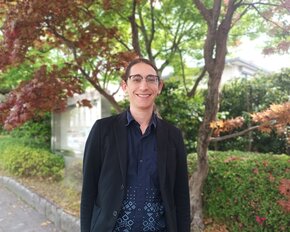
I serve on the Center's Steering Committee as well as the Editorial Committee for the Center's journal, ART RESEARCH. Additionally, I coordinate the International ARC Seminar, our twice-monthly guest lecture series, and assist with a wide range of administrative duties, especially those involving English-language communications.
You first became connected with the ARC during your internship at the Smithsonian. Could you share more about that experience?
Seifman: In the summer of 2011, I spent about ten weeks as a digitization intern at the Freer-Sackler Galleries (now the National Museum of Asian Art), at the Smithsonian Institution, where I had the opportunity to experience the ARC's Digital Archiving Model firsthand. Along with two fellow interns, and under the guidance of Dr. Ryoko Matsuba, we photographed some 2,000 Japanese woodblock-printed and other illustrated books from the 17th to 20th centuries.
2025年3月22日(土)に、第14回「知識・芸術・文化情報学研究会」を開催いたします。
下記の通り第14回の研究集会の→参加者申し込みを受け付けておりますので、奮ってご参加ください。 またこの会は、ARC-iJACの若手研究者カンファレンスとして位置付けられています。
「知識・芸術・文化情報学研究会」について
昨今のデジタル・情報環境の急速な進展とともに、学術分野にも「情報」や「デジタル」を意識した分野横断型の研究が多く見受けられるようになってきました。大学の教育・研究活動においても、この傾向は強まっており、これに関連する教育プログラムやコースの活動が充実しています。
時代に即した新しい研究テーマのもと、このような課程で学ぶ学部生・大学院生や若手研究者が学術的な交流をする機会へのニーズはますます大きくなっています。
そのため、芸術・文化、およびその他の関連する分野の情報・知識研究に興味のある大学院生および若手研究者を主に意識し、発表・交流のための場として「知識・芸術・文化情報学研究会」を2011年度に発足させ、これまで13回の研究集会を開催しました。
本会は、異分野の人的交流を通じて、参加者相互が新たな研究テーマや方法を発見できる場と位置づけており、学会発表とはひと味違う萌芽的・冒険的な発表も歓迎します。■ 日時:2025年3月22日(土) 12:30開始
■ 実施方法:ハイブリッド開催
■ 会場:立命館いばらきフューチャープラザ カンファレンスホール(立命館大学 大阪いばらきキャンパス内)
〒567-8570 大阪府茨木市岩倉町2-150 (https://www.ritsumei.ac.jp/futureplaza/conferencehall/)■ オンライン:Zoom使用
■ プログラム・発表要旨は→こちらです。
■ 2025年3月19日(水)までに、参加申し込みフォーム https://forms.gle/FrhobaK3SYL34zQa6 よりお申し込みください。
※参加費は無料です。
※研究発表会後に懇親会を予定しています(対面のみ)。大学や分野の枠を超えた交流の場にしたいと思いますので、あわせてご参加ください。会場、参加費等は決まり次第ご案内します。■問い合わせ:kacimeeting+2025■gmail.com (■を@に変えて下さい)
主催:知識・芸術・文化情報学研究会
世話役〔五十音順〕:赤間亮(立命館大学)、阪田真己子(同志社大学)、田窪直規(近畿大学)、村川猛彦(和歌山大学)、山西良典(関西大学)
共催:情報知識学会関西部会、アート・ドキュメンテーション学会関西地区部会
協力:立命館大学アート・リサーチセンター 文部科学省 国際共同利用・共同研究拠点「日本文化資源デジタル・アーカイブ国際共同研究拠点」[イベント情報]2025年3月12日(水)立命館大学研究活動報『RADIANT』では、「Building an international DX consortium for Japanese arts and culture digital humanities research, with Ritsumeikan as the central node」と題して、ARCセンター長赤間亮教授(文学部)のデジタルアーカイブプロジェクトが紹介されました。 共同研究の概要、共同研究者と2024年度に開催されたシンポジウムやセミナー等が紹介されています。
記事サイト: https://en.ritsumei.ac.jp/research/radiant/global/impact/?id=7
立命館大学アート・リサーチセンター(ARC)は、このたび「ARC古地図ポータルデータベース」の本格稼働を開始いたしました。本データベースには、ARCが所蔵する貴重な古地図に加え、カリフォルニア大学バークレー校(UC Berkeley)をはじめとする大規模なコレクションを含め、総点数5,000枚以上の古地図が収録されています。
今回、大英図書館(The British Library)所蔵の日本の古地図311点を本データベースに登載するにあたり、IIIF仕様のピラミッド型(タイル型)表示機能を追加いたしました。これにより、古地図をより柔軟かつ快適に閲覧することが可能となりました。
ARC古地図ポータルデータベース
https://www.dh-jac.net/db/maps/search_portal.php大英図書館 日本の古地図データベース
https://www.dh-jac.net/db/maps/search_BL.php今後は、すでに登載されている古地図も、ピラミッド型表示ができるようにしていくとともに、さらに多くのコレクションを加え、データベースの規模を拡大してまいります。
さらに、本データベースの活用を広げるため、ジャパンサーチなどへの掲載も積極的に進めてまいります。最初に、2025年3月末を目途に大英図書館所蔵の日本の古地図をジャパンサーチに登録する予定です。
この公開により、さらなる研究の発展が期待されます。是非ご活用ください。
[イベント情報]2025年2月22日(土)日時:2024年2月21日(金)10:00~16:50、2月22日(土)10:00~17:00(予定)
会場:ハイブリッド開催 ARC+オンライン(ZOOM) (YouTube ライブ配信あり★)主催:立命館大学アート・リサーチセンター、文部科学省 国際共同利用・共同研究拠点「日本文化資源デジタル・アーカイブ国際共同研究拠点」、日本文化デジタル・ヒューマニティーズ拠点「研究拠点形成支援プログラム」
プログラムはこちらです。
[イベント情報]2025年2月21日(金)日時:2024年2月21日(金)10:00~16:50、2月22日(土)10:00~17:00(予定)
会場:ハイブリッド開催 ARC+オンライン(ZOOM) (YouTube ライブ配信あり★)主催:立命館大学アート・リサーチセンター、文部科学省 国際共同利用・共同研究拠点「日本文化資源デジタル・アーカイブ国際共同研究拠点」、日本文化デジタル・ヒューマニティーズ拠点「研究拠点形成支援プログラム」
プログラムはこちらです。
2月19日(水)午後6時~8時(日本標準時間)、Web配信にて、国際ARCセミナー特別編「大英図書館地図コレクションを含むARCの日本古地図オンラインの公開」を開催いたします。
テーマ:「大英図書館地図コレクションを含むARCの日本古地図オンラインの公開」
2000年代以降、歴史地理学と地理情報科学を融合した歴史GISは、デジタル・ヒューマニティーズの一環として、日本国内および世界的に急速に発展している。しかし、日本における近現代の地図や台帳などの地理空間データの多くは、電子化されておらずGIS形式では利用できない状態にある。歴史GISを発展させるためには、紙ベースの地理空間データをデジタル化し、GIS形式に変換して一般に公開することが不可欠である。さらに、博物館の学芸員や教育者などGISの専門家ではない人々にも利用してもらうためには、オンライン検索やGIS分析のための使いやすいフレームワークが必要である。
本セミナーでは、1)日本の古地図のプラットフォームとなる「ARC Map Portal Database」、2)「Map Warper」の日本語版、3)「日本古地図オンライン」の開発を紹介する。これらのコンポーネントにより、ユーザーは古地図を検索・選択し、ジオレファレンスされた地図を共有し、さまざまなトピックに関する詳細な地図を作成することができる。
ARC Map Portal Databaseを作成するために、国内外の機関が所蔵する古地図をデジタル化し、一般公開し、ジャパンサーチに公開する。地図は検索を容易にするために、日本語と英語のバイリンガル・メタデータで標準化される。日本のMap Warperでは、非営利目的で地図を利用できるようにし、クラウドソーシングによるジオリファレンスを導入して地図の精度を高める。
今回は世界最大規模の地図コレクションを有する大英図書館が所蔵する400近い日本の古地図をデジタル化し公開したことを報告し、その内容について、Oxford大学のXia-Kang Ziyi博士からお話をいただく。
プログラムは下記となります。
司会:Dr. Travis Seifman(立命館大学衣笠総合研究機構・准教授/現ARCリサーチマネージャー)
講演者:
18:00-18:45
Dr. Xia-Kang Ziyi(オックスフォード大学アジア・中東学部)
「大英図書館所蔵の日本地図:過去と現在」18:45-19:15
矢野桂司教授(立命館大学文学部地理学教室・ARC副センター長 )
「日本古地図のオンライン構築」19:15-20:00 質疑応答・デモ
略歴
シャ・カン・ツィイ博士(オックスフォード大学アジア・中東研究学部)
シャ・カン・ツィイ博士は最近、オックスフォード大学で東洋学の博士号を取得した。彼女の論文は、徳川日本と朝鮮半島間の関係における対馬藩の役割について考察している。彼女は、近世東アジアにおける外交や異文化交流、および徳川幕府の政治権力に関心を持っている。2023年初頭、彼女は、大英図書館古地図部門のマップキュレータであるトム・ハーパー氏と共同で、博士論文のプロジェクト「大英図書館所蔵の1900年以前の日本製地図」に取り組んだ。現在はオックスフォード大学で教鞭をとっている。矢野桂司教授(立命館大学文学部地理学専攻およびアート・リサーチ)
矢野桂司(理学士、理学修士、博士(理学))は、2002年4月より立命館大学(京都)の人文地理学・地理情報科学の教授を務めている。1992年に立命館大学に入職する前は、東京都立大学で地理学助手として勤務し、博士号を取得した。専門分野は、日本学術会議会員(https://www.scj.go.jp/en/index.html)、人文地理学会会長(http://hgsj.org/english/)、日本地理学会理事(https://www.ajg.or.jp/en/)、 また、GIS学会の元会長(https://www.gisa-japan.org/english/index.html)でもある。研究関心は、地理情報システム(GIS)の利用と都市分析における定量的手法に集約される。これには、GIS内での情報統合、ジオデモグラフィックス、ジオデザイン、空間相互作用モデル、都市モデリング、仮想都市、デジタル人文学、定量的地理学の歴史、GISの歴史などが含まれる。
日時:2025年2月19日(水)午後6時~8時(日本標準時間)
参加:Zoom配信(関係者のみ・予約不要)
※ARCメンバー以外の方は Youtubeよりご参加いただけます。こちらからご覧下さい。



